Cisco CCNA Ethernet Technologies
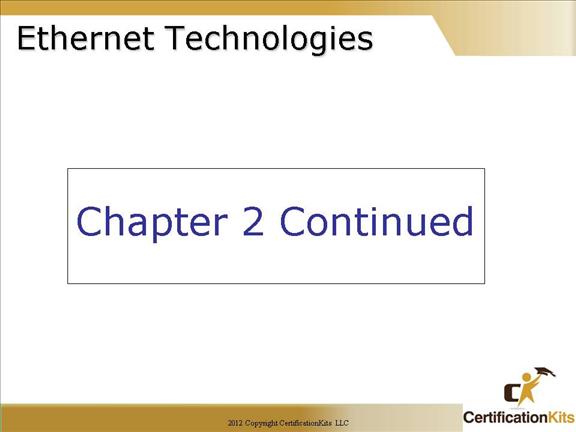
Ethernet is a contention media access method that allows all hosts on a network to share the same bandwidth of a link.
Ethernet is popular because it’s readily scalable, meaning it’s comparatively easy to integrate newer technologies, like Fast Ethernet, Gigabit Ethernet and 10 Gigabit Ethernet into an existing network infrastructure.
It’s also relatively simple to implement in the first place, and with it, troubleshooting is reasonably straightforward. Ethernet uses both Data Link and Physical layer specifications.
Cisco CCNA IEEE 802.3 LAN
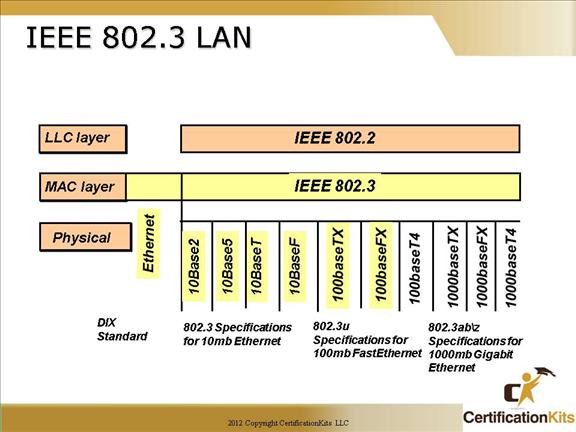
Ethernet was first implemented by a group called DIX (Digital, Intel, and Xerox).
They created and implemented the first Ethernet LAN specification, which the IEEE used to create the IEEE 802.3 Committee.
This was a 10Mbps network that ran on coax, twisted-pair, and fiber physical media.
The IEEE extended the 802.3 Committee to new committees known as 802.3U (FastEthernet) and 802.3aband 802.3z (Gigabit Ethernet) and 802.3ac (10-Gig).
These are both specified on twisted-pair and fiber physical media.
Cisco CCNA CSMA/CD
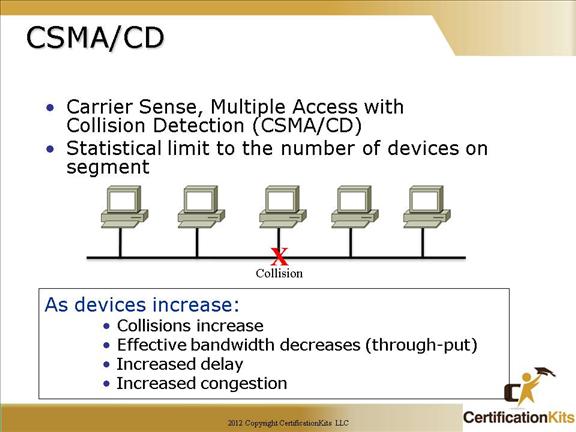
Ethernet networking uses Carrier Sense Multiple Access with Collision Detect (CSMA/CD), a protocol that helps devices share the bandwidth evenly without having two devices transmit at the same time on the network medium.
CSMA/CD was created to overcome the problem of those collisions that occur when packets are transmitted simultaneously from different nodes.
üUsed in Half-Duplex Ethernet networks.
üHalf-duplex is single pair for both transmit and receive.
üIf a collision does occur, the transmitting host sends an extended jam signal, which tells all hosts to stop transmitting.
üBackoff algorithm is the retransmission delay that is enforced when a collision occurs. This causes global synchronization which reduces performance.
While CSMA/CD is important to know about, most of today’s ethernet is switch ethernet which utilizes a full duplex connection and eliminates the need for CSMA/CD since there is no possibility of a collision on a full duplex ethernet connection.
Cisco CCNA Internetworking Terms
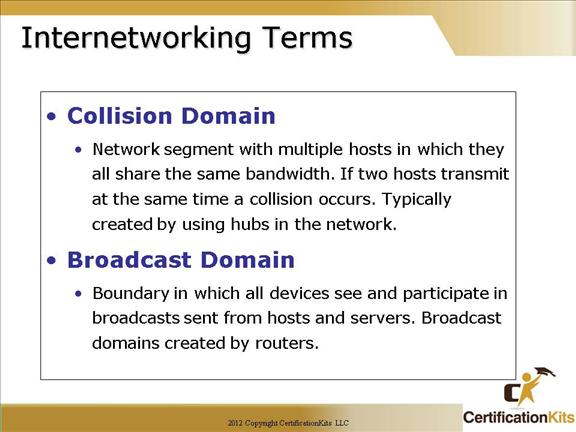
By default, switches break up collision domains. This is an Ethernet term used to describe a network scenario wherein one particular device sends a packet on a network segment, forcing every other device on that same segment to pay attention to it. At the same time, a different device tries to transmit, leading to a collision, after which both devices must retransmit, one at a time. Not good—very inefficient! This situation is typically found in a hub environment where each host segment connects to a hub that represents only one collision domain and only one broadcast domain. By contrast, each and every port on a switch represents its own collision domain.Routers, by default, break up a broadcast domain, which is the set of all devices on a network segment that hear all broadcasts sent on that segment.
Breaking up a broadcast domain is important because when a host or server sends a network broadcast, every device on the network must read and process that broadcast—unless you’ve got a router.
Switches create separate collision domains, but a single broadcast domain. Routers provide a separate broadcast domain.
Hence, collision domains are defined at layer 2 and broadcast domains are defined at layer 3.LAN comp
Cisco CCNA Frame Types
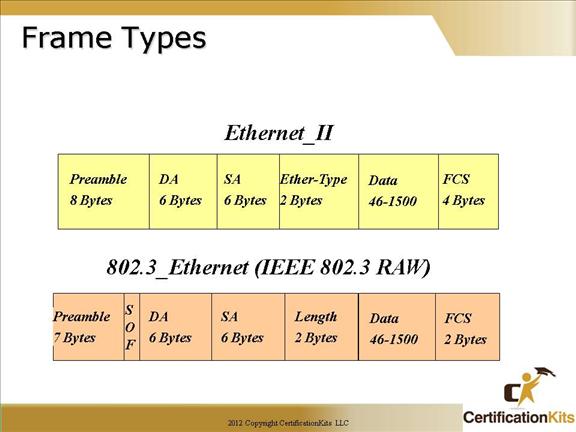
Field Definitions:
Preamble: Consists of seven or eight bytes of alternating 1s and 0s used for synchronization.
Start of Frame (SOF): Contains bits that signal the transmission of the actual frame is about to start.
Destination Address (DA): Contains the MAC address of the local network to which the packet is being sent.
Source Address (SA): Contains the MAC address of the sending host.
Type/length: In Ethernet II it contains a code that identifies the network layer protocol. In 802.3 it specifies the length of the data field.
There are four different types of Ethernet frames available:
Ethernet_II
IEEE 802.3
IEEE 802.2
SNAP
Cisco CCNA 802.3 with LLC (802.2)
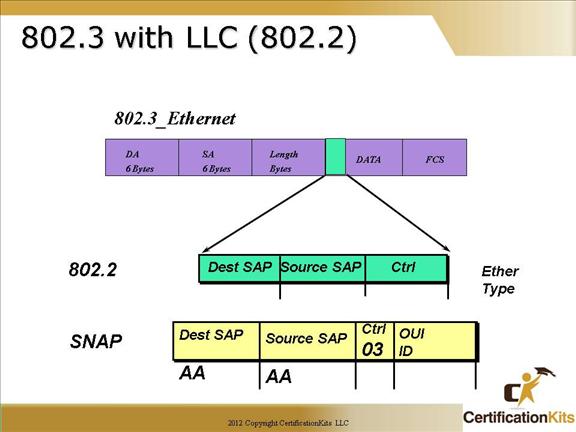
Since the 802.3 Ethernet frame cannot by itself identify the upper-layer (Network) protocol, it obviously needs some help. The IEEE defined the 802.2 LLC specifications to provide this function and more.
802.2 uses Destination and Source Service Access Points (SAP’s) to identify the Network layer protocol
The SNAP frame has its own protocol field to identify the upper-layer protocol. This is really a way to allow an Ethernet_II Ether-Type field to be used in an 802.3 frame.
Cisco CCNA MAC Address
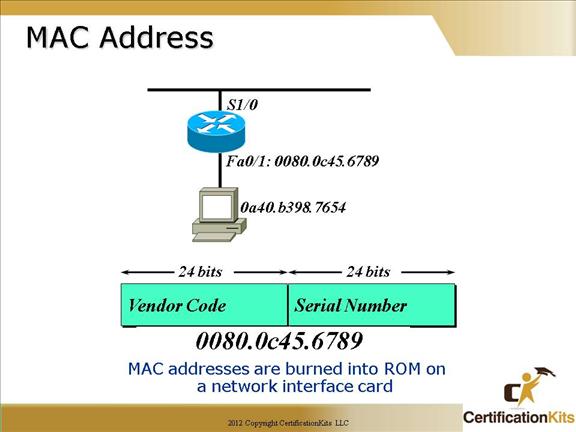
Unique for each local area network (LAN) interface
48-bit address
Expressed as 12 hexadecimal digits
Example is as follows:
0080.0c12.abcd
First six hexadecimal digits (0008.0c in example above) contain manufacturer identification (vendor code) also called Organizational Unique Identifier (OUI).
Manufacturer IDs administered by IEEE. The last six hexadecimal digits (12.abcd in example above) are essentially a serial number administered by the manufacturer. Hence, there should never be a duplicate MAC address anywhere in the world.
Note: hexadecimal numbers can contain the following numbers and letters:
“0 – 9” and “a – f”
Cisco CCNA Duplex Overview
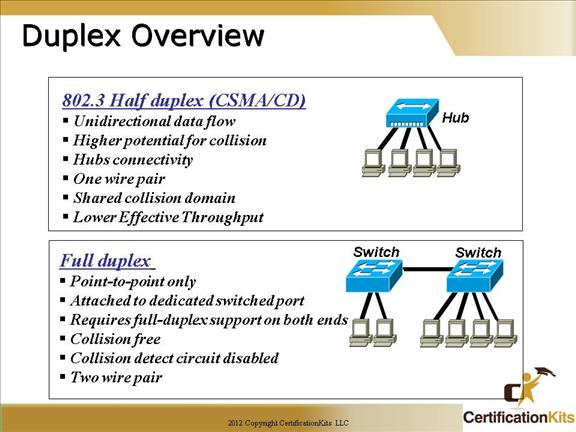
Half-duplex Ethernet is defined in the original 802.3 Ethernet and uses only one wire pair with a digital signal running in both directions on the wire.
It also uses the CSMA/CD protocol to help prevent collisions and to permit retransmitting if a collision does occur.
If a hub is attached to a switch, it must operate in half-duplex mode because the end stations must be able to detect collisions. Half-duplex Ethernet—typically 10BaseT—is only about 30 to 40 percent efficient as Cisco sees it, because a large 10BaseT network will usually only give you 3- to 4Mbps—at most.
But full-duplex Ethernet uses two pairs of wires, instead of one wire pair like half duplex. And full duplex uses a point-to-point connection between the transmitter of the transmitting device and the receiver of the receiving device. This means that with full duplex data transfer, you get a faster data transfer compared to half-duplex. And because the transmitted data is sent on a different set of wires then the received data, no collisions will occur—sweet!
üFull-Duplex is collision free
üHalf-Duplex is subject to collisions
üFull-Duplex provides higher throughput than Half-Duplex Ethernet of the same bandwidth
üHalf-Duplex operates in a shared collision domain
üFull-Duplex operates in a private collision domain
Cisco CCNA Shared With Hubs
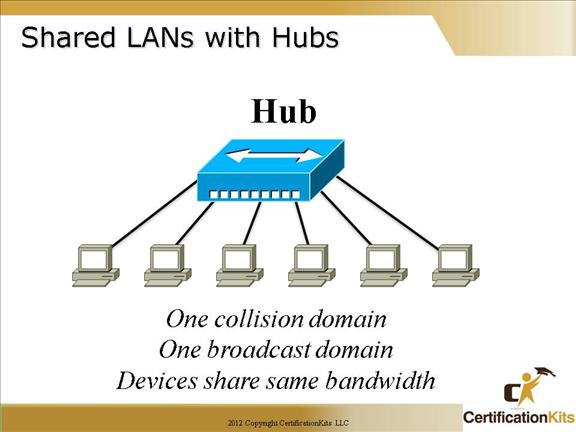
A hub is really a multiple-port repeater. A repeater receives a digital signal and re-amplifies or regenerates that signal, and then forwards the digital signal out all active ports without looking at any data.
An active hub does the same thing. Any digital signal received from a segment on a hub port is regenerated or re-amplified and transmitted out all ports on the hub.
This means all devices plugged into a hub are in the same collision domain as well as in the same broadcast domain.
